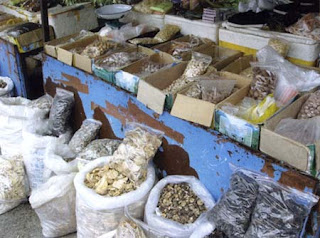Marketing of Non-Timber Forest Products in Community Forestry of Nepal
 Abstract
AbstractNepal's Himalaya, globally significant and biologically diverse ecosystem produces wide range of inimitable and valuable Non Timber Forest Products(NTFPs). NTFPs are often common property resources, like fuel wood , fodder, charcoal , fencing , poles , medicinal plants , and a variety or foodstuffs, such as game , fruit and nuts, mushrooms, fibre, and resins. Use of medicines from the forest often overlaps with forest food use. The most important category of NTFPs is the loose group termed as Medicinal and Arommatic Plants(MAPs). Regardless of size, Nepal is famous for floral and faunal diversity in the world. Out of 15,000 identified plant species in this country, more than 2000 plants have medicinal properties and more than 100 plants species are in commercial trade. There is growing concern in governmental and non-governmental organization to promote NTFPs for improvements of rural livelihoods and forest conservation.
Introduction
Generally people get confused with the term 'Non-Timber Forest Products(NTFPs) 'whether tourist , horn of rhino, skin of tiger, bones of different animals etc. should be classified as 'timber' or 'non-timber' products . In fact, all other products except timber, fuel wood and fodder are classified as NTFPs. Not only in Nepal but all over the world the attraction towards NTFPs is increasing in a rapid way.
Every year, thousand of tonnes of NTFPs representing over 100 species are harvested from forestland in the middle hills and high mountains of Nepal and traded to India. Most of the NTFPs products are being exported to India in Raw form however several processing plants have been developed nowadays for value addition before export.
Medicinal Plants
Use of Plants parts as medicine was only a mean of healing in traditional practices in Nepal. This healing practices are still in practice in rural areas through 'Baidhya' , 'Dhami' ,'Amchi' , 'Guruba' , etc. Ayurbedic medicines are being popular in city areas also. There are more than 700 medicinal plants identified in Nepal.
Some medicinal plants and their use are tabulated below
Table 1
Common Name of NTFPs Scientific names Medicinal Use
Atis Delphinium himalayense Root is used as medicine for fever
Amala Phyllanthus emblica source of Vitamin-C, food digestion
Harro Terminalia chebula skin diseases, ingredients of Trifala
Barro Terminalia belarica ingredients of Trifala
Kutki Neopicrorhiza srophulariflora Lever and lung problems,fever, blood purification
Kurilo Asparagus racemosus fever, lactating women
Chirayita Swertia chirayita Fever, stomachache
Bhojo Acorus calamus cough and cold , fever
Nepal is recognized all over the world by the community forestry . So, people living in the rural areas of Nepal especially those , who live nearby the forest(Community Forest) are heavily dependent on the forest in order to collect the NTFPs. NTFPs selling is a major source of income for rural people. Large amount of NTFPs are harvested and traded every year in different Community Forests by the users.
Why NTFPs get exploited in large Scale in Nepal?
In large scale NTFPs get exploited due to the following reasons.
Reduction in biomass of the selected NTFPs in the area.
Left out of fewer plants for regeneration by seeds.
Invasion or domination by surrounding or associated species.
Micro and Macro level changes in the ecological area.
Significant loss of nutrient capital in the ecosystem.
The minerals that are taken up by the forest trees are eventually returned in the forest soil.
Decay of debris provides shelter or host to insects or fungus that attack NTFPs
Too much disturbances of habitat trampling by moving feet and vehicles , by dragging logs and firewood while skidding and transportation.
Marketing/Trading of Non-Timber Forest Products
Marketing implies that entrepreneurs access the market demand for products , identifying opportunities and constraints to fulfill the demand and develops strategies to reach the targeted market. NTFPs are emerging rapidly in the globally marketplace. At a time when the markets for the environmental services of forests are being increasing promoted , many countries and organizations see a great deal of potential for these forest products and services in the process of sustainable development and poverty alleviation. NTFPs are very important for many communities, particularly the rural poor. The trade in some high-value NTFPs also contributes to the national economy. However, the benefits are not always distributed equitably and markets are often informal , disorganized and open to exploitation.
Conclusion
The trade of NTFPs is a major source of income in high hills, however institutionalization of NTFPs traded at Community Forestry is non-functional. The Community Forest User Group(CFUG) members on individual basis do collection and trade of NTFPs collected from Community Forest as well from the adjoining National Forests. Due to limited information and lack of co-operation and coordination among stakeholders ,there are many challenges in NTFPs marketing. The Policy and Regulations are acting as a barrier in institutionalized trade of Community Forest based on NTFPs. Kamal Bhusal,Bachelor in Forestry


You can choose from farmhouses, cottages, farm buildings, or even a whole estate! If you’re not sure what would be best for you, we recommend talking to our consultants about what kind of property would suit your needs best.